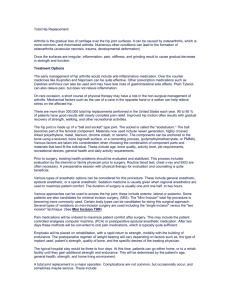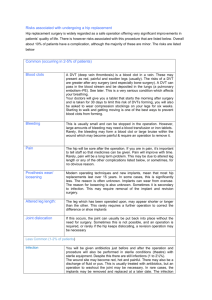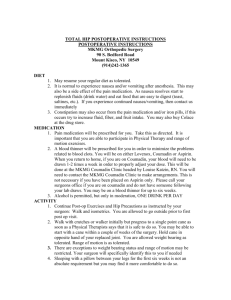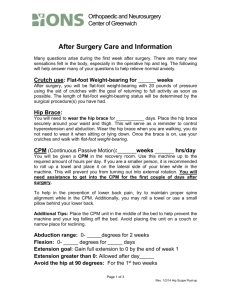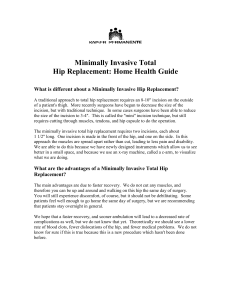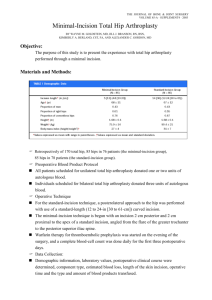Discharge Instructions for Total Hip Replacement
advertisement
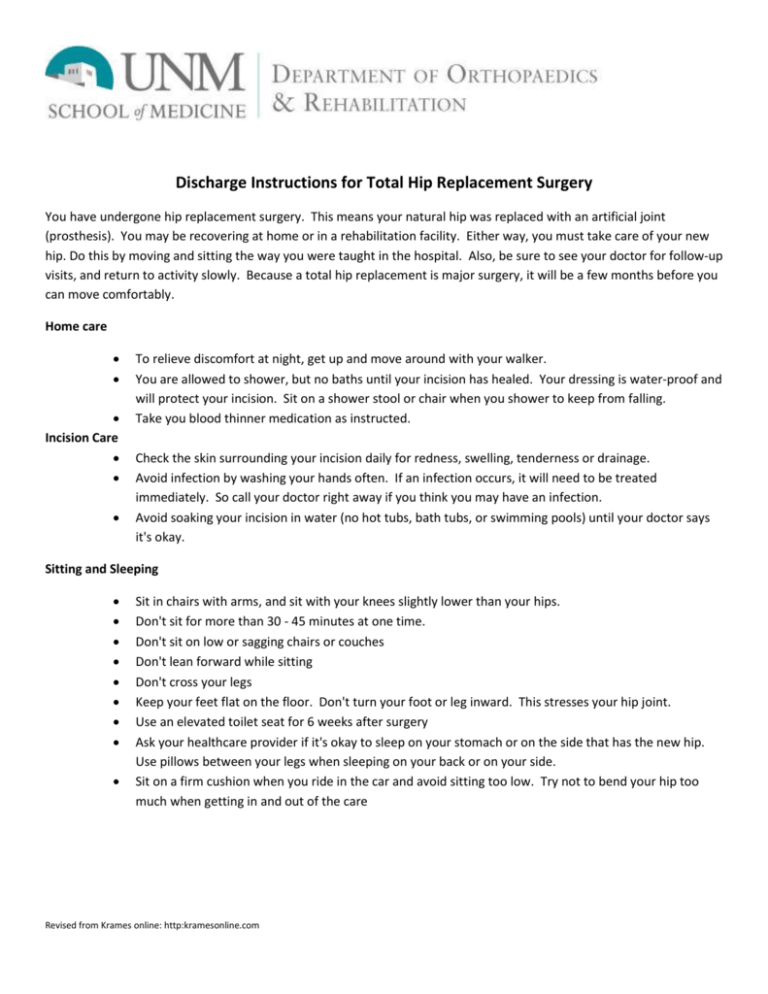
Discharge Instructions for Total Hip Replacement Surgery You have undergone hip replacement surgery. This means your natural hip was replaced with an artificial joint (prosthesis). You may be recovering at home or in a rehabilitation facility. Either way, you must take care of your new hip. Do this by moving and sitting the way you were taught in the hospital. Also, be sure to see your doctor for follow-up visits, and return to activity slowly. Because a total hip replacement is major surgery, it will be a few months before you can move comfortably. Home care Incision Care To relieve discomfort at night, get up and move around with your walker. You are allowed to shower, but no baths until your incision has healed. Your dressing is water-proof and will protect your incision. Sit on a shower stool or chair when you shower to keep from falling. Take you blood thinner medication as instructed. Check the skin surrounding your incision daily for redness, swelling, tenderness or drainage. Avoid infection by washing your hands often. If an infection occurs, it will need to be treated immediately. So call your doctor right away if you think you may have an infection. Avoid soaking your incision in water (no hot tubs, bath tubs, or swimming pools) until your doctor says it's okay. Sitting and Sleeping Sit in chairs with arms, and sit with your knees slightly lower than your hips. Don't sit for more than 30 - 45 minutes at one time. Don't sit on low or sagging chairs or couches Don't lean forward while sitting Don't cross your legs Keep your feet flat on the floor. Don't turn your foot or leg inward. This stresses your hip joint. Use an elevated toilet seat for 6 weeks after surgery Ask your healthcare provider if it's okay to sleep on your stomach or on the side that has the new hip. Use pillows between your legs when sleeping on your back or on your side. Sit on a firm cushion when you ride in the car and avoid sitting too low. Try not to bend your hip too much when getting in and out of the care Revised from Krames online: http:kramesonline.com Moving Safely The key to successful recovery is movement by walking and exercising your hip as directed by your doctor and physical therapist. Don't bend at the hip when you bend over. Don't bend at the waist to put on socks and shoes. And avoid picking up items from the floor. Use a cane, crutches, a walker, or handrails until your balance, flexibility, and strength improve. And remember to ask for help from others when you need it. Follow your doctor's orders regarding how much weight to put on the affected leg. Don't drive until your doctor says it's okay. Most people can start driving about 6 weeks after surgery. Don't drive while you are taking narcotic pain medication. Follow Up A follow up appointment will be made for you 10 - 14 days after your surgery. Other Precautions Tell all your healthcare providers - including your dentist - about your artificial joint before any procedure. You will likely need to take antibiotics before dental work and other medical procedures to reduce the risk of infection. Arrange your household to keep items you need handy. Keep everything else out of the way. Remove items that may cause you to fall, such as throw rugs, and electrical cords. Use non-slip bath mats, grab bars, an elevated toilet seat, and a shower chair in your bathroom. Keep your hands free by using a backpack, fanny pack, apron or pockets to carry things. Prevent infection. Ask your doctor for instructions if you haven't already received them. Any infection will need to be treated immediately with antibiotics. Signs of infection are listed below. Maintain a healthy weight. Get help to lose any extra pounds. Added body weight puts stress on the hip. Take any medications you have been given after surgery. This may include blood thinning medications to prevent blood clots or antibiotics to prevent infection. Be sure to take ALL your antibiotics. Pain Management In the hospital you were getting pain pills about every 2 hours. Now that you are going home it is time to start thinking about getting off of the pain pills. We cannot take away your pain; we do want to manage it so you can continue your daily activities of living and physical therapy. Start increasing the time between your pain pills. For example: if you were getting pain pills every 2 hours, then start taking pain pills every 3 hours, then every 4 hours etc... By 2 weeks after your surgery you should only be using prescribed pain pills prior to physical therapy and at night before you go to bed. You should not be using prescribed pain pills by 6 weeks after your surgery. Once you have stopped taking your blood thinners, Rivaroxaban, Lovenox, Arixtra or Aspirin, it is safe to start taking Ibuprofen. You can take ibuprofen during the day and use your prescribed pain pills at night and during therapy. Revised from Krames online: http:kramesonline.com When to seek Medical Attention Call 911 right away if you have: Chest pain Shortness of breath Any pain or tenderness in your calf Otherwise call your doctor immediately if you have: Fever of 100.4 0 F or higher, or shaking chills Stiffness or inability to move the knee Increased swelling in your leg Increased redness, tenderness, or swelling in or around the hip incision Drainage from the hip incision Increased hip pain Revised from Krames online: http:kramesonline.com
